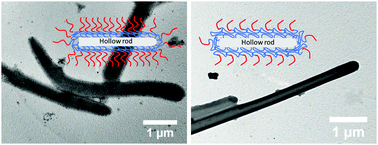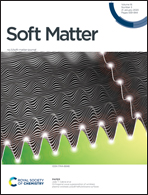Hollow polymer microrods of tunable flexibility from dense amphiphilic block copolymer brushes†
Abstract
Polymer microrods of aspect ratio ∼10, and tunable flexibility are attractive model systems to study density and index matched liquid crystalline phases. However, the synthesis of anisotropic polymer particles is arduous, due to the lack of directional polymer growth mechanisms. In this work, non-cross-linked, hollow polymer microrods are developed from a dense block copolymer brush grown from the surface of micron-sized silica rods. The copolymer brush, comprising a hydrophobic inner block and a hydrophilic outer layer, is synthesized by surface-initiated atom transfer radical polymerization, and is exploited in the preparation of robust polymer rod particles in water, following etching of the inorganic core. The solvent-incompatible inner block is crucial for the synthesis of the rod-like polymer particles, in the absence of chemical cross-links, and the block copolymer composition affects the colloidal stability and flexibility of the hollow anisotropic colloids. For shorter hydrophobic block lengths, well-defined, yet flexible, hollow rods are obtained, whereas increasing the hydrophobic content of the copolymer results in rigid, tube-like particles. The approach is generic and could be easily employed to obtain polymer rod particles in any solvent medium, upon the appropriate selection of the solvent-incompatible inner block and the solvent-compatible outer block.



 Please wait while we load your content...
Please wait while we load your content...